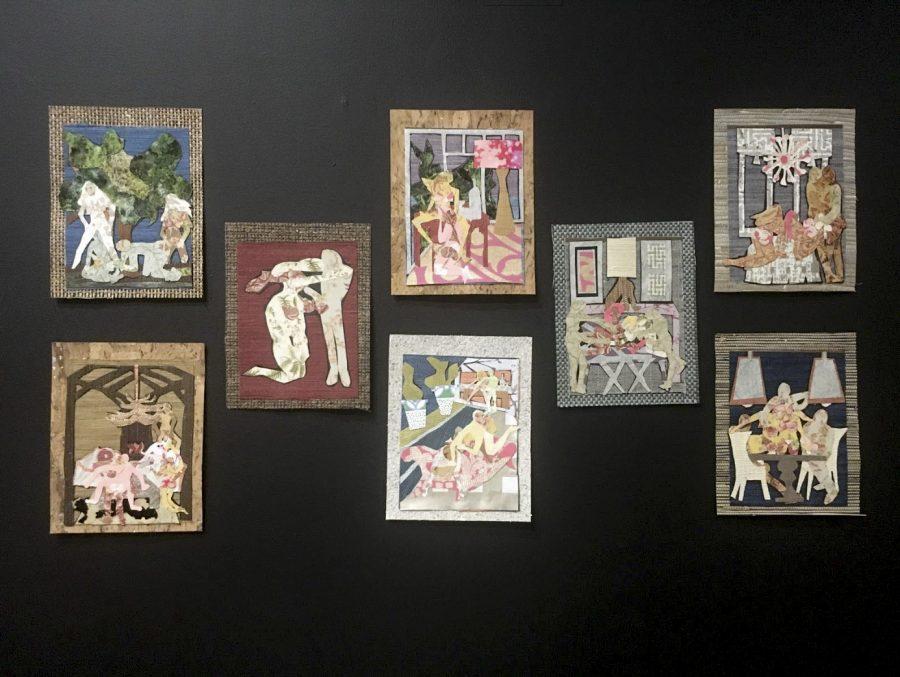Feminism Revisited in X-Plicit Art
“Coming to Power: 25 Years of Sexually X-Plicit Art by Women” featured in The Maccarone Art Gallery showcases 25 years worth of work curated by various female artists.
September 19, 2016
The only feature that catches the eye is the stark, black-and-white sign reading “MACCARONE.” It’s hung next to an unassuming industrial entrance, where a dark shadowy void beckons visitors into “Coming to Power: 25 Years of Sexually X–Plicit Art by Women.”
The space is unadorned, L–shaped, filled with concrete and track lighting. Five black walls, one bubblegum pink. The colors, lights and works draw the eye towards the brightness of the rosy hue. Occupying the space is the story of women and sex, inexplicably combined and cooperating through every medium. Over the 25 years the exhibit’s work spans, co-curated by Pati Hertling and Julie Tolentino, these female artists (including Niv Acosta, Jim Fletcher, FlucT, Xandra Ibarra/La Chica Boom, Kia Labeija and Narcissister) have worked to expose and embrace the idea of sexual desire — specifically, what that desire means for women who refuse to hide it behind closed doors or keep it tucked beneath layers of skirts and civility.
The gallery guides the viewer from darkness into the light, mimicking the journeys of the artists. Directly facing the front door is the first highlighted work: three raised black pedestals, about breast height, containing a diaphragm, a condom and a birth control pill. It is the beginning: the small, simple objects that fight on the front lines for sexual expression to be uninhibited by its natural consequences.
As the viewer moves through the gallery, they pass bold paintings and collages. The vibrant colors and multitude of acts involving varying sexual orientations, cultures and mediums offer the visitor a broad spread of artists who had the rare courage to represent the act of sex in public art. There is a feeling of nakedness and discomfort as the viewer gradually assimilates into their new visual environment.
Then, a pink wall is reached. A certain lightness of soul is felt; poetry, whimsicality, a distance from reality. Abstract patterns, handwriting, soft figures. It creates, in a sense, the emotions of sex. A new level of understanding presents itself. Femininity is embraced, and women are empowered.
Black walls return, a heaviness falls over the gallery. Now the halls are filled with dark coloring and shadowy images — leather, pimples and shocked expressions. Sounds emanating from a small television featuring a passionate scene add a fitting soundtrack. The more psychologically complex side of sex is aroused, and a new visual template is acquired. The viewer seems to be looking in on the private desires of the artists and their subjects.
All of a sudden, the exhibit ends. A woman looks longingly out the window in a photograph. Seemingly sad and bored, the exhibition closes.
The journey that the visitor undertakes while experiencing “Coming to Power” is one where both feminist history and self–discovery combine to open the eyes and mind. Where have we been? Where are we going? This exhibition celebrates the feminist movement both as it was and as it is today. It shows the deep wrinkles of complexity that women experience every day as humanity grapples with the question of the private life of desire. The artists whose works compile “Coming to Power” have laid the foundation for future generations to continue to push the envelope and question boundaries, both public and private. It offers a new definition of what it means to be free.
“Coming to Power: 25 Years of Sexually X–Plicit Art by Women” is on display at Maccarone at 630 Greenwich St. through Oct. 16.
A version of this article appeared in the Sept. 19 print edition. Email Emily Conklin at [email protected].





























































































































































